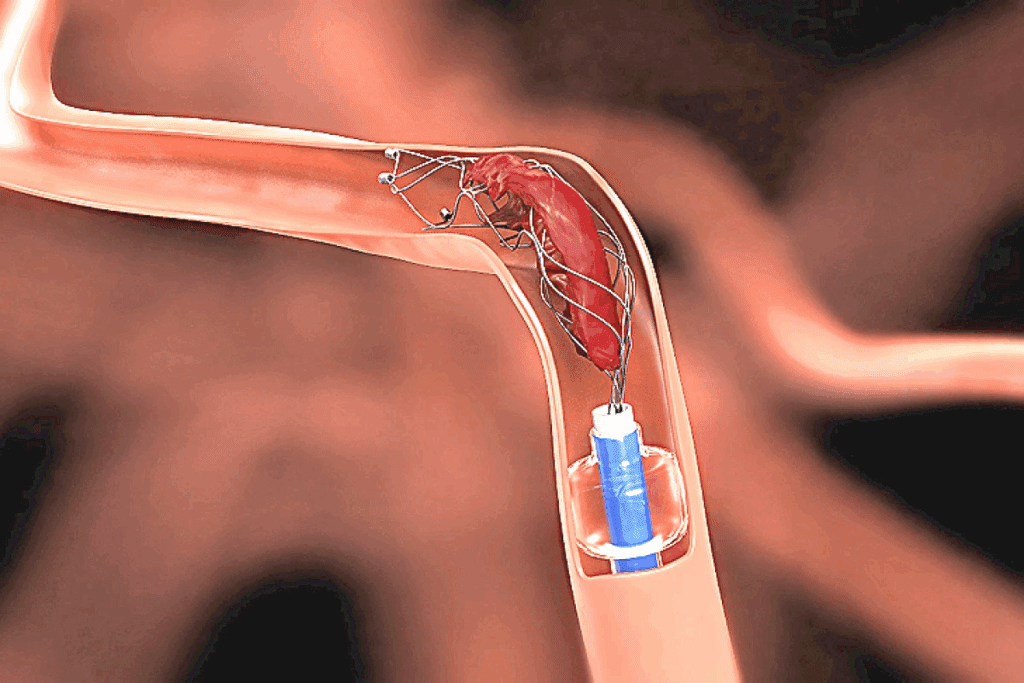Last Updated on November 26, 2025 by Bilal Hasdemir

If you have a cardiac stent or are thinking about getting one, you might wonder: can I count on this implant for a long time? It’s important to know that cardiac stents are meant to be permanent. Their lifespan depends a lot on how healthy your arteries are. Learn how long does a cardiac stent last and factors affecting its lifespan.
At Liv Hospital, we focus on top-notch cardiac care and put our patients first. Today’s heart stents are made from strong materials like stainless steel or cobalt chromium. According to a journal , these stents are built to last forever if your arteries stay healthy.
Key Takeaways
- Cardiac stents are designed to be permanent implants.
- Their longevity is closely tied to overall artery health.
- Modern stents are made from durable materials.
- Proper care and healthy living are key for long-term success.
- Regular monitoring is necessary to prevent complications.
Understanding Cardiac Stents

Cardiac stents have changed how we treat heart disease. They offer a less invasive way to keep arteries open. This helps restore blood flow to the heart.
What Is a Cardiac Stent?
A coronary stent is a small, mesh-like tube. It’s made of metal or polymer, sometimes with a drug coating. It acts as a scaffold inside a coronary artery. Its main job is to prevent blockages and keep the artery open, ensuring blood flows well to the heart muscle.
Why Cardiac Stents Are Placed
Cardiac stents are used during an angioplasty to treat coronary artery disease. They help keep the artery open. This improves blood flow to the heart and reduces symptoms like chest pain.
The Stenting Procedure
The stenting procedure involves inserting a balloon and stent into a narrowed artery. When the balloon is inflated, it expands the stent. The stent then presses against the artery walls, keeping it open and allowing blood to flow freely.
| Procedure Step | Description |
| 1. Insertion | A catheter with a balloon and stent is inserted into the narrowed coronary artery. |
| 2. Inflation | The balloon is inflated, expanding the stent against the artery walls. |
| 3. Deployment | The stent remains in place, keeping the artery open after the balloon is deflated and removed. |
Understanding cardiac stents is key for patients undergoing angioplasty. Knowing how stents work and their role in restoring blood flow is important. It helps patients appreciate the benefits and outcomes of the procedure.
Types of Cardiac Stents

Cardiac stents have evolved, giving patients more options. Each stent has its own benefits and features. It’s important for doctors and patients to know about these differences.
Bare-Metal Stents
Bare-metal stents are made from metals like stainless steel. They are:
- Simple in design
- Less expensive than newer stents
- Good at keeping arteries open
But, they are more likely to cause restenosis than drug-eluting stents. Restenosis means the arteries can narrow again, needing more treatments.
Drug-Eluting Stents
Drug-eluting stents have a special coating that stops tissue growth. This helps prevent restenosis. These stents are:
- Less likely to cause restenosis
- Improve patient outcomes over time
- Often chosen for PCI procedures
But, patients with these stents must take antiplatelet drugs. This is to avoid blood clots.
Bioresorbable Vascular Scaffolds
Bioresorbable stents dissolve over time. They offer:
- Normal vessel function return
- Less risk of long-term problems
- Better imaging of the vessel later
These stents are new and are being studied. Their long-term effects are being watched.
Choosing a stent depends on many things. These include the patient’s health, the blockage, and the stent’s risks and benefits. As cardiology advances, new stents will likely improve patient care.
How Long Does a Cardiac Stent Last?
The life of a cardiac stent depends on several factors, like the stent type. These devices keep arteries open, improving heart blood flow. The success and longevity of these stents are key for patient health.
Permanent Nature of Metal Stents
Metal stents are meant to stay in the artery forever. They act as a permanent scaffold, keeping the artery open. This permanence means fewer repeat procedures for patients.
A study in the Journal of the American College of Cardiology found metal stents are a mainstay in treating coronary artery disease. They offer a lasting solution for patients.
“The durability of metal stents is a key factor in their widespread adoption, providing a long-term solution for patients with coronary artery disease.”
Expected Functional Lifespan
The lifespan of a cardiac stent is how long it keeps the artery open. Even though metal stents are permanent, their success depends on patient health and lifestyle. Regular check-ups are vital to keep the stent working.
- Drug-eluting stents release medication to prevent cell growth, lowering restenosis risk.
- Bare-metal stents rely on the body’s healing to keep the artery open.
Differences in Longevity Between Stent Types
Stent types vary in how long they last and how well they work. Drug-eluting stents, for instance, lower restenosis risk more than bare-metal stents. Bioresorbable vascular scaffolds (BVS) dissolve over time, aiming to reduce long-term issues.
A study showed that drug-eluting stents have less restenosis than bare-metal stents. This makes them a top choice for many. The right stent choice is essential for long-term success.
The Process of Restenosis
Restenosis is when a treated artery narrows again. This is a big concern for how long a cardiac stent lasts. It can happen after a stent is placed, leading to less blood flow to the heart.
What Is Restenosis?
Restenosis is when the artery treated with a stent narrows again. This happens when the body tries to heal the stent. It can cause too much tissue to grow, narrowing the artery. This is a big worry because it can bring back symptoms or even worse heart problems.
Timeframe for Restenosis Development
Restenosis usually happens within the first 6 months after a stent is put in. During this time, the risk is highest. The exact time can vary based on the stent type and the patient’s health.
Incidence Rates in Different Stent Types
The chance of restenosis changes with different stents. Bare-metal stents have a higher risk than drug-eluting stents. Drug-eluting stents release medicine to stop too much tissue growth. Bioresorbable vascular scaffolds are a new technology trying to lower restenosis risk even more. Knowing these differences helps us manage patient care and expectations.
Every patient is different, and many things can affect restenosis risk. Lifestyle, health, and medication are key. By understanding restenosis, we can improve heart health after stent placement.
First Year After Stent Placement
The first year after getting a cardiac stent is very important. It’s a time when patients need to watch closely and follow their treatment plans. They are at a higher risk for problems like blood clots and restenosis.
Critical Monitoring Period
The first 12 months after a stent is put in are key. Regular check-ups with your healthcare provider are vital. They help keep an eye on the stent and catch any problems early. A leading cardiologist says, “Close monitoring can greatly lower the risk of complications.”
Common Complications
Two big problems after stent placement are blood clots and restenosis. Blood clots can block the stent, while restenosis is when the artery gets narrow again. Sticking to antiplatelet therapy is key to avoiding these issues.
- Blood clots: Form inside the stent, which can block it.
- Restenosis: The artery gets narrow again, often due to tissue growth.
When Risk of Restenosis Decreases
The risk of restenosis is highest in the first year. But it goes down a lot after 6-12 months. Drug-eluting stents make this risk much lower after the first year. Living a healthy lifestyle and taking your meds as directed are very important in reducing this risk.
“The risk of restenosis decreases over time, making long-term outcomes more favorable for patients who adhere to their treatment plans and make necessary lifestyle adjustments.”
Understanding the first year after stent placement is key. Taking proactive steps can greatly improve long-term results.
Long-Term Outcomes of Cardiac Stents
Cardiac stents play a big role in heart health. Many studies look at how well they work over time. By watching patients after stenting, we learn a lot about these devices.
5-Year Survival Rates (86% and Beyond)
Research shows that patients with cardiac stents often live for 5 years or more. This is thanks to better stent technology and care for patients.
Looking at different studies, we see that survival rates depend on several things. These include the stent type, patient age, and health before stenting.
| Stent Type | 5-Year Survival Rate |
| Bare-Metal Stents | 82% |
| Drug-Eluting Stents | 88% |
| Bioresorbable Vascular Scaffolds | 85% |
7-11 Year Clinical Outcomes
Outcomes after 5 years are also key. They show how well stents keep working over time. Studies show that patients do well for 7 to 11 years after stenting.
But, there’s a small chance of serious heart problems during this time. This shows that stents are mostly effective.
Late Luminal Narrowing Concerns
One worry with stents is late luminal narrowing. This is when the artery gets narrower again. Modern stents lower this risk, but it’s something to watch for.
We suggest regular check-ups to catch any narrowing early. This way, we can act fast if needed.
Factors Affecting Stent Longevity
Knowing what affects stent longevity is key for those who have had cardiac stenting. The life of a cardiac stent can change based on health, lifestyle, and following care instructions.
Health Conditions Impacting Stent Longevity
Some health issues can really shorten a stent’s life. For example, diabetes can lead to faster plaque buildup and more restenosis. Keeping blood sugar in check is very important for those with diabetes.
High cholesterol and hypertension also matter a lot. It’s vital to manage these with medicine, diet, and lifestyle to keep the stented artery healthy.
| Health Condition | Impact on Stent Longevity | Management Strategies |
| Diabetes | Increased risk of restenosis and plaque buildup | Blood sugar management, medication adherence |
| High Cholesterol | Potential for plaque accumulation | Dietary changes, statins, regular check-ups |
| Hypertension | Increased stress on the stented artery | Medication, lifestyle modifications, and monitoring blood pressure |
Importance of Medication Adherence
Following your medication plan is critical for keeping the stent open and your heart healthy. Antiplatelet therapy is key in the first year to prevent clots. Not taking your meds can cause serious problems, like stent thrombosis.
It’s important to talk to your doctor about your meds and why you need to take them.
Smoking and Other Lifestyle Risk Factors
Smoking is a big risk for stent failure and restenosis. Quitting smoking is a must for anyone with a stent. A sedentary lifestyle and eating too much saturated fat can also harm your stent.
Being active and eating well can help your stent last longer and keep your heart healthy.
By managing these factors, patients can make their stents last longer and keep their hearts in good shape.
Essential Lifestyle Changes After Stenting
After getting a cardiac stent, it’s key to live a heart-healthy lifestyle. This helps keep the stent working well and keeps your heart in good shape. We suggest making diet changes, exercising regularly, and managing stress.
Dietary Recommendations for a Healthy Heart
Eating a balanced diet is important for heart health. Focus on fruits, vegetables, whole grains, and lean proteins. Try to cut down on saturated fats, cholesterol, and sodium.
Adding foods rich in omega-3s, like salmon and walnuts, is also good. They help your heart stay healthy.
Exercise Guidelines for Stent Patients
Staying active is vital for heart health after stenting. Start with easy exercises like walking or yoga. Then, slowly increase how hard and long you exercise, as your doctor advises.
Managing Stress for a Healthy Heart
Too much stress can harm your heart. Try stress-reducing activities like meditation, deep breathing, or hobbies. These can help keep your stress levels down.
By making these lifestyle changes, people with cardiac stents can get healthier. They can also lower their risk of heart problems in the future. We’re here to help you on your path to a healthier heart.
FAQ
How long do cardiac stents typically last?
Cardiac stents are made to last forever with the right care. But, how long they last can change based on the stent type, your health, and lifestyle.
What is the difference between bare-metal stents and drug-eluting stents in terms of longevity?
Bare-metal stents and drug-eluting stents face different risks of clogging. Drug-eluting stents have a lower risk. Both can last for years with good care.
How long does it take for restenosis to develop after stent placement?
Restenosis usually happens within 1-6 months after a stent is put in. But, it can happen later too. The risk goes down after the first year.
What factors can affect the longevity of a cardiac stent?
Things like diabetes, high cholesterol, and smoking can affect a person’s life. Changing your lifestyle and following your treatment plan can help.
How important is the first year after stent placement?
The first year is very important. It’s when the risk of problems, like clogging, is highest. Keeping an eye on your health and following your treatment is key.
Can lifestyle changes impact the longevity of a cardiac stent?
Yes, living a heart-healthy life can help your stent last longer. Eating right, exercising, and managing stress are all important.
What are the long-term outcomes for patients with cardiac stents?
Studies show patients with stents can do well over time. They can live up to 86% of the next 5 years and have good results for 7-11 years.
How long do stents last in the heart?
With the right care, stents can last for many years. In some cases, they can work forever.
What is the lifespan of a heart stent?
The life of a heart stent varies. But metal stents are usually seen as permanent.
How long can a stent last?
How long a stent lasts depends on many things. But, with good care, they can last for years.
References
- Kastrati, A., Mehilli, J., & Schömig, A. (2000). Long-term outcome after coronary stenting. European Heart Journal, 21(24), 2024–2032. https://pmc.ncbi.nlm.nih.gov/articles/PMC59599/






